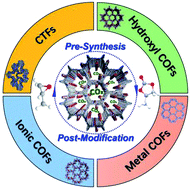Tailored covalent organic frameworks for simultaneously capturing and converting CO2 into cyclic carbonates
Abstract
The catalytic cycloaddition of CO2 to epoxides is one of the most promising and green pathways for CO2 utilization in industry. In recent years, covalent organic frameworks (COFs) as a flourishing class of organic porous materials have been widely used for efficient capture and conversion of CO2. By virtue of the flexible regulation of pore parameters and the task-specific introduction of catalytically active components into their crystalline structures, well-designed COFs with tailored functions and stable and ordered frameworks may be a viable alternative to metal–organic frameworks (MOFs) so as to meet the multifaceted requirements of CO2 activation and transformation. This review describes the recent advances made with regard to the design and synthesis of tailored COFs for simultaneously capturing and converting CO2 into cyclic carbonates. Given the presence of different kinds of catalytically active sites, we have divided recently reported COFs into four main categories, i.e., covalent triazine frameworks (CTFs), hydroxyl-decorated COFs (hydroxyl COFs), metal-functionalized COFs (metal COFs) and ionic liquid-modified COFs (ionic COFs). The rational design of organic polymeric monomers and the wise choice of the pre-synthesis or post-modification strategy have been extensively emphasized and discussed here in detail. We expect that valuable guidance and a unique overview may be provided towards CO2 conversion into cyclic carbonates, thereby developing numerous function-led COFs with excellent industrial application prospects.



 Please wait while we load your content...
Please wait while we load your content...